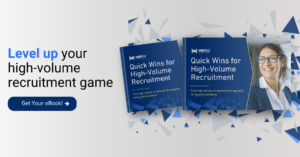Introduction
Welcome to Part 3 of our Actionable Hiring blog series.
In Parts 1 and 2, we’ve previously discussed practical strategies to optimize the recruitment funnel and steps to build a responsive talent pool. Whether you need 10, 50, or 1,000 hires, these strategies work for any employer in high-volume or skilled recruitment.
These include:
- Auditing the recruitment process
- Adopt and/or combine screening tools with an instantaneous human assessment
- Build relationships with candidates proactively with social media, professional networks, and industry-specific forums
- Engage your talent pool regularly so that you can mobile quickly when a job arises
Now, let’s dive into the best part–measuring success. With the pace of talent acquisition, it’s critical we proactively innovate and pivot as the market needs it. And contrary to popular belief, you don’t need an intense tech stack to measure success.
Let’s dive in.
Step 1: Identify Key Metrics to Track
Our recruitment teams don’t need to be perfect for every metric. But, it’s important to define what success looks like, and that will be different for every organization. If you’re in high-volume hiring, success looks like a short time-to-fill. For skilled talent hiring, success may look like having a low turnover rate.
Define clear metrics for success, including time-to-fill, cost-per-hire, and quality of hire. Utilize your Applicant Tracking System (ATS) to monitor these metrics regularly, gaining insights into recruitment performance.
Step 2: Analyze and Adjust
Now that you have the metrics defined, it’s time to determine how and when you will evaluate and adjust strategies. It can be monthly or quarterly. Again, it depends on the type of hiring. The key is to schedule regular reviews of recruitment metrics and start identifying trends and areas of improvement.
At Mindfield, we have regular meetings with hiring managers and clients to ensure we’re on track in-quarter. How often are you having these conversations? Remember, it’s better to have one than none.
Step 3: Foster a Culture of Continuous Improvement
The biggest barrier we’ve seen at Mindfield when it comes to analytics is actually in the team culture. Do your hiring managers and recruiters work collaboratively? Do they feel safe to share opinions that may be difficult to hear? It’s important to foster an open, honest culture in order to see long-term continuous improvement. Remember, we’re all working towards the same goal.
The key? Create channels for feedback from hiring managers, candidates, and the recruitment team. Look for ways to encourage experimentation with new strategies and tools, and don’t forget to recognize successes! This will enable a culture of innovation and enhancement.
Why is this important?
Enterprise HR organizations in high volume and skilled recruitment have learned that you must diversify your recruitment tactics by testing an array of methods across all recruitment processes, policies, and practices. No single strategy or tactic will work unless the rest of the puzzle makes sense. A culture of continuous improvement is paramount to achieving this.
Conclusion & Real-World Example: How We Get Real-Time Metrics without the Fuss:
You don’t need complex technology to access real-time metrics. For instance, Mindfield provides clients with comprehensive insights through a simple hiring portal connected to their HRIS. This portal offers macro and micro views of essential metrics like open jobs, applications received, response rates, and key recruitment metrics. Weekly meetings enable the hiring team to discuss these metrics, identify challenges, and devise actionable plans for improvement.
By implementing these strategies and leveraging real-time metrics, recruitment teams can optimize performance, drive efficiency, and achieve success in their hiring endeavors.
Ready to elevate your talent acquisition game? Download the full “Actionable Hiring: Quick Wins for High-Volume Recruitment” guide to access comprehensive strategies and expert insights.
About Cameron Laker and Mindfield:
We offer streamlined and effective recruiting solutions that alleviate the recruitment burden from hiring managers, leading to consistent, high-quality hires and allowing managers to focus on their primary business operations.
Connect with Co-Founder Cameron Laker on Linkedin for quick tips and how-to’s or sign up to The Hourly Minute for more in-depth discussion.






